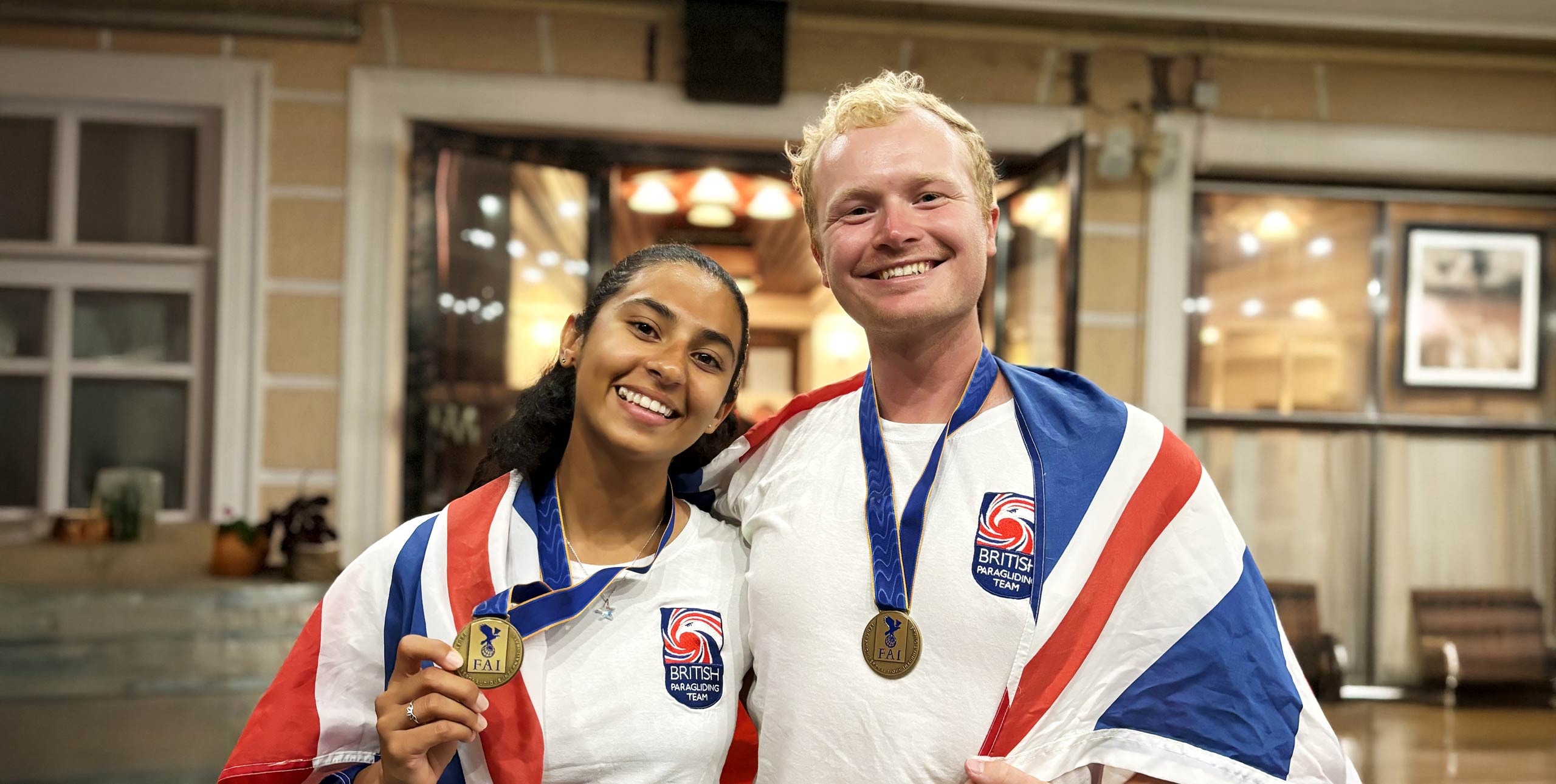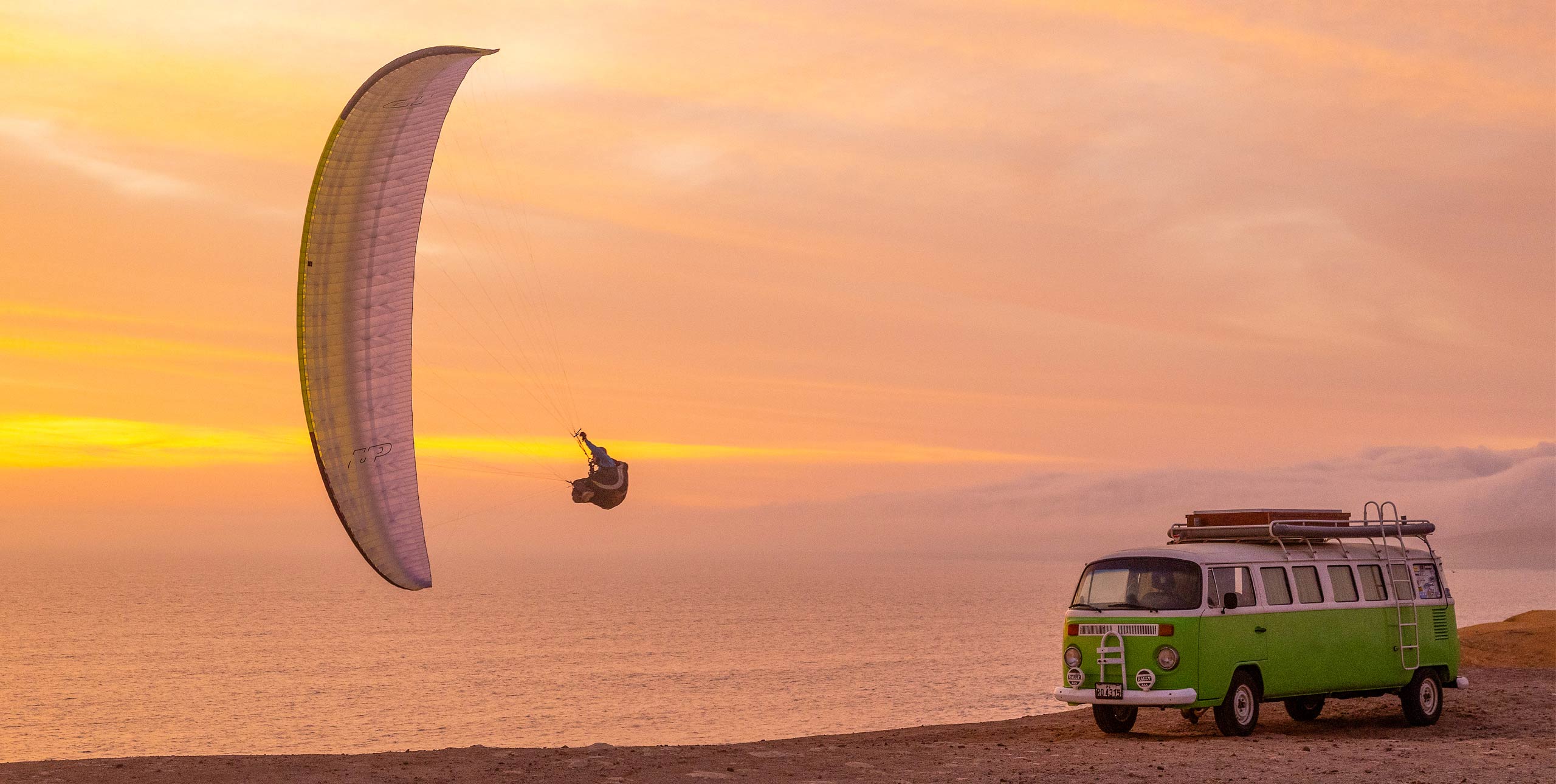Hugh Miller reviews the Freex Oxygen, a paraglider designed to win you gold and the blushes of Britney Spears, or whichever pop kitten was top of the pops back when this was published, a hundred years ago in 1999…
Truth testing is the essence of a glider review. Taking the manufacturer’s promises and testing them against the reality of a hostile sky, that sort of thing. So when FreeX announced they had ‘A Champion’s Wing’, I had no choice but to take their Oxygen M to PWC Slovenia to win gold, struggle to raise the weight of a colossal trophy, and suffocate under the laurels and hot kisses from the podium girls. We’d see.
I have to say I approached the Oxygen with caution. My last experience of flying a FreeX glider was in 1996, when I tested the Spark Pro and got so freaked I nearly called a psychologist. I also tried out the Fiber, Freex’s first performance glider, and the Frantic intermediate, but was unimpressed by either. After such experiences, the mere utterance of ‘special FreeX handling’ was enough to make me cower in the bushes at take off with fear.
So what a relief it was to pull up the Oxygen and discover a straight-handling, no-quirks glider that is a pleasure to fly. I was expecting to have to put in several hours of airtime to get used to the expected ‘special handling’, but in the first minute I felt as at home as a granny swinging in her porch hammock in Texas sipping lemonade. I had a ten minute scratch about in mid-Wales, flying a grassy hill top in a light wind, and the Oxygen contoured the slope perfectly, always following my inputs to the word and smoothly co-ordinating my turns.
CONSTRUCTION
The sail cut of the Carrington cloth is immaculate, perhaps the cleanest currently available, and serves to give a very sleek appearance. The brake fan at the trailing edge gives an unruffled curve as the brakes are pulled. Four risers allow a standard speed-system pull, with 13.5 cm of distance between the pulleys giving 27 cm of travel, just the right amount of leg extension.
The like-them-or-hate-them trademark FreeX tip ears make a showing, albeit in reduced size (the fabric measures just 14 cm by 32 cm), and serve to attach the span-tensioning stabiliser lines to the rear section of the chord. Normally stabiliser lines run down to the B-riser, but FreeX have opted for the D riser, a design move which increases resistance to tip collapses because as the wing dives, it’s tips are held back.
Factory pilot Daniel Crespo (Sp) was flying his white Oxygen proto at PWC Kobarid and it was looking a little cosmetically tired, but a suck on the cloth showed no signs of porosity after his 150 hours of logged flying in Argentina and Spain.
SECURITY
Stalling
In May there was a rumour going round that the Oxygen has a deep stall problem. A fellow British pilot had just returned from PWC Como where he alleged his Oxygen had deep-stalled him into the trees. Such slur is enough to jeopardise the success of any new release, so when I returned home to the south of France, I drove to St Andre-les-Alpes to try and separate speculation from fact.
A thousand metres above the lake, the horizon fell behind my knees as the glider mushed back into a deep stall. I’d forced my hands low, with my arms locked straight, tweaking under the strain. Once the glider had dropped back, reluctantly swapping forward flight for stall, I raised the brakes to half brake and with a jerk the glider surged forward again, tugging at my harness. I tried again to get the Oxygen to come to terms with life as a parachute, but it just wouldn’t have it. Since testing the glider, I’ve flown thirty hours on the Oxygen, mostly in strong lee-side conditions, and have never even come close to a gust-induced deep stall. Nor did the DHV when they certified the glider.
Asymmetric Collapses – Not an issue. During seven hours of PWC racing, mostly in the lee of 2000 m vertical limestone scenery, I never endured so much as a tip closure. On the first task, I surfed up a cliff-line to the summit of Krn Mountain just behind Walter Holtzmuller and Rob Whittall. The glider rode through the choppy air, and it was easy to keep up with my company despite the fact that both pilots are notoriously good in strong air and one of them was on a racy new Nova proto only a week old. The Oxygen allowed me the thinking space to appreciate the beauty of my position in a way I had never been previously allowed. In the First World War, a million soldiers fought and died in the mountain trench-lines and fortifications along the Krn summit ridge. There I was, just cruising in the afternoon sun, taking in a piece of history. It was enough to forget there was a task on.
Full Frontal Collapses
Back in St Andre, I had pulled in 70% asymmetrics and the glider had dived and rolled out to a full recovery with 90 degrees. Pulling both A risers to simulate a full frontal resulted in the expected: a gentle folding of the leading edge followed by a quiet opening behind my head and then a dive that needed some damping.
Spinning
Imagine you’re flying along a crowded ridge, as is often the scenario at competitions, and you have a close call. In a desperate bid to avoid collision, you jab down hard on your right brake forcing it down as your mind panics. The Oxygen will comply by twisting back its right tip in a stall, and the left wing will dive quickly allowing a rapid turn. As long as you then let up after 90 degrees, the right wing will then dive and everything will be fine. The stall point is recognisable and entry is not overtly dynamic but appreciable and manageable.
HANDLING
I believed FreeX gliders generally have light handling, but the Oxygen has moderate brake pressure right through the range from brake pulley to below the seat. I don’t mind heavier pressures as long as the handling retains precision and the feedback is direct, and this is just how the Oxygen flies. It’s an immediate glider with no delay to its responses and reactions.
Combine this attribute with its excellent behaviour at low angles of attack and you’ve got a wing that just loves to bite into strong rough cores and fling itself skywards, mounting the Gs up on you.
When entering a strong thermal there’s hardly any ‘knock-back’; instead the risers will pull at your sides as the glider rolls to let you know which way you should be turning. Next, as your wing settles into the core, a little weight shift will drop you into a turn after which you can really wang the glider round with the brakes.
On the second task at PWC Kobarid, when there was a 10 kph wind blowing from the lee-sides, it was often easy to wind it up in stuff that bigger span, higher apsect ratio prototypes could only nibble the edges of. The Oxygen’s stability at extreme nose-down angles of pitch make for easy wing-overs, as Daniel Crespo often demonstrates. I’m not entirely sure how the Oxygen will perform in lighter, smoother thermals, because although its sink rate seems fine, it feels like it is built for big air.
When gliding, the speed bar is light enough and feels solid up to half bar. Before taking off on the third day I loaded up with five litres of ballast, putting my total weight up from 94 kg to 99 kg, and the benefit in trim speed and glide performance was measurable. The trim speed felt a good 2 kph faster, and best glide seemed just as good as the Edel Sector TX4s and Nova X-Perts I was flying with.
PERFORMANCE
The PWC Serial Class has shown just how unnecessary competition gliders are. In Slovenia, French coach Yves Gouselain finished 14th overall on a standard Edel Response. He beat 81 open class pilots, perhaps each of whom had as much as a 10 kph speed advantage over Yves. They have absolutely no excuse for their failure to beat him. Serial class gliders are here, they are safe, and they perform. A well-loaded Oxygen goes very well indeed. Weighing in at 99 Kg, I clocked the Oxygen at 51 kph flat out and 38 kph hands-off. On the first task Othar Lawrence (USA) and I glided 10 km into goal, wing tip to wing tip, and there seemed to be nothing in it between his large Firebird Rocket and my medium Oxygen. I also glided against the Ozone Protons and couldn’t tell much difference.
SUMMARY
At the end of two tasks amid some of Europe’s most beautiful mountains, I found myself stood on the podium, third in the serial class behind two pilots I greatly respect, Yves Gouselain and Bruce Goldsmith. I enjoyed flying a glider that never once collapsed or caused me concern but still retained the dynamics and precision that I have grown used to over my last three years of flying hotter competition wings. It’s a wing that’s built for big air and as such is only suited to those experienced pilots totally at home in strong conditions.
The Reviewer – Hugh Miller has been flying since 1992 and competing since 1994. In 1997 he was British Champion and World Air Games Champion. During his time, he has flown over 50 different gliders, and has competed on the Trekking Espace, Pro-Design Contest, and Nova’s Xyon, Xenon, Nexon and X-Pert. He prefers direct handling and fast turning gliders. Hugh has been sponsored to compete by Nova since 1997. The performance tests were conducted with a Skywatch Pro set to an averager of 6 seconds at Gourdon, south of France, 11/6/99, in calm air to allow safe acceleration at 1000 m asl. Accurate speed readings are notoriously difficult to achieve, and readers should be aware that 5-10% inaccuracy can occur.
• Got news? Send it to us at news@xccontent.local
Subscribe to the world’s favourite hang gliding and paragliding magazine








